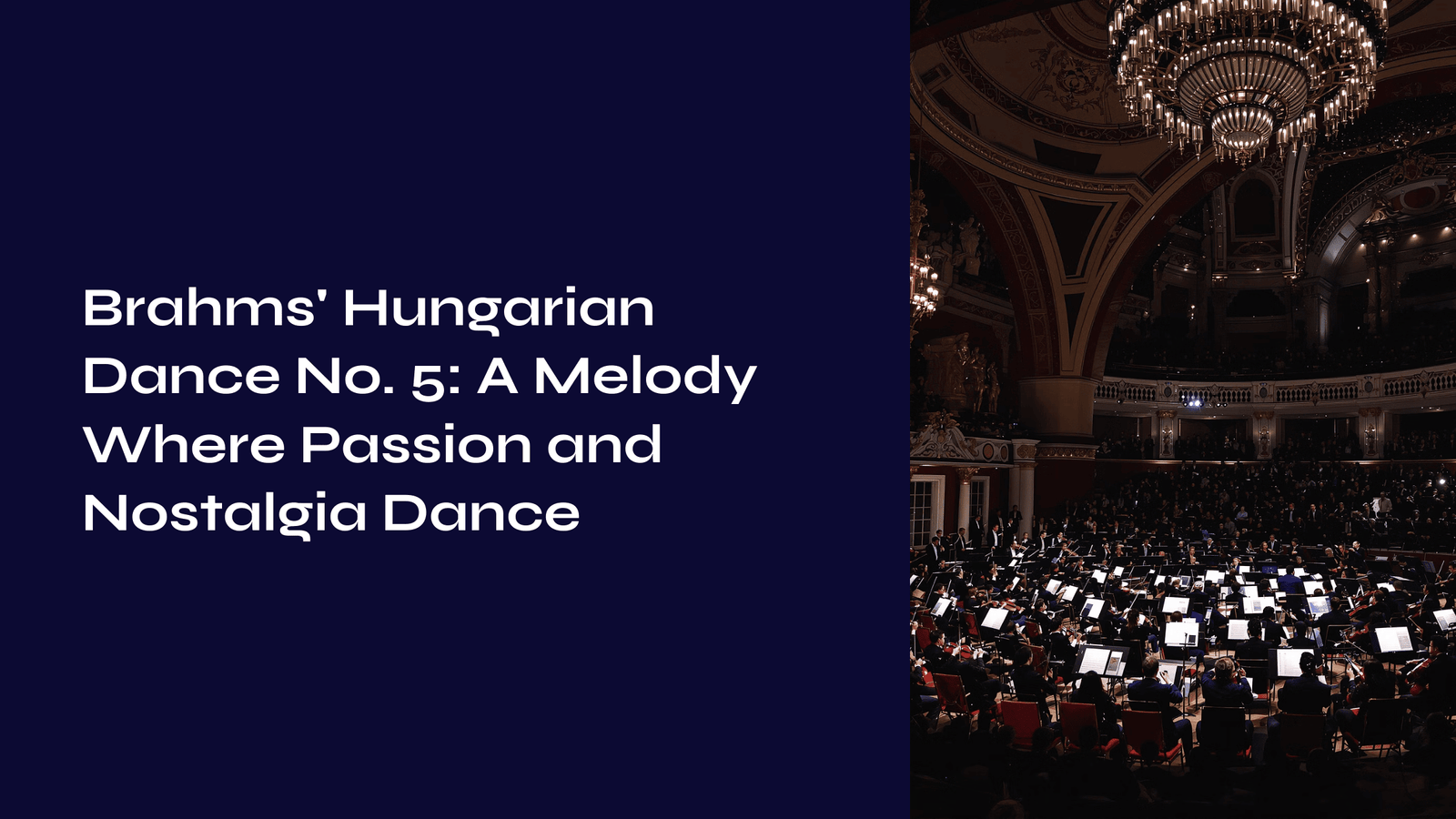Table of Contents

An Unforgettable First Impression
In middle school music class, our teacher played a piece that filled the entire classroom. Beginning with an intense introduction, the music immediately captivated us all. The melody, sometimes passionate and sometimes gentle, seemed to tell someone’s story. That first encounter with Brahms’ Hungarian Dance No. 5 left a deep impression on me and became the first classical piece that drew me into the charm of classical music.
Since then, whenever I hear this familiar melody in movies, commercials, or TV programs, my heart flutters with excitement. Today, I’d like to share with you the story and beauty hidden within this captivating piece.
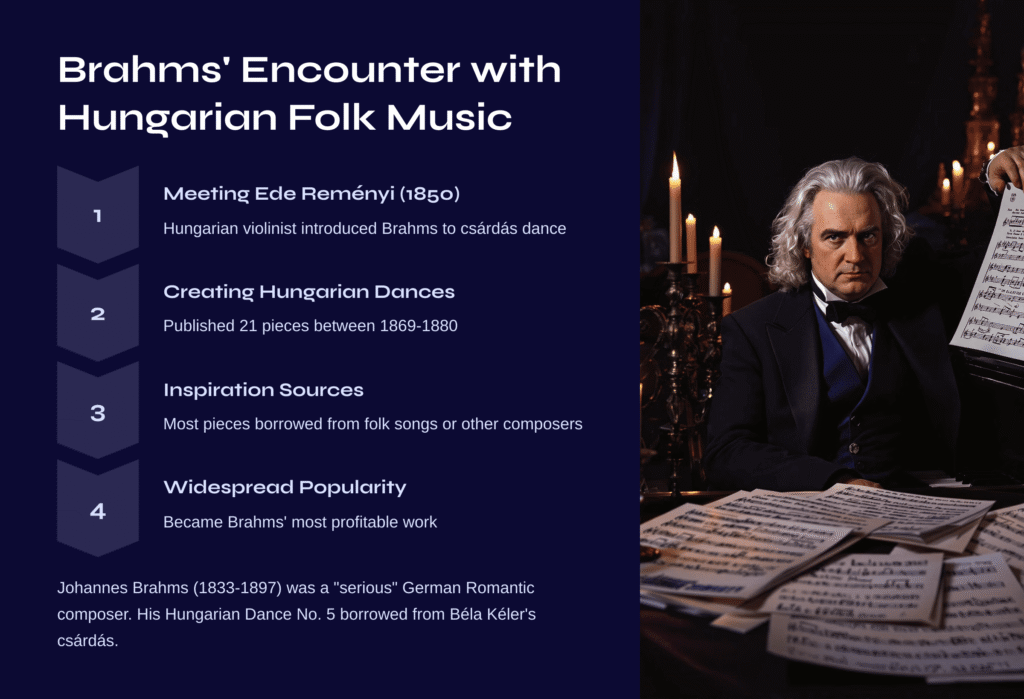
Brahms’ Encounter with Hungarian Folk Music
Johannes Brahms (1833-1897) was a German Romantic composer known as a “serious” composer continuing the tradition of Beethoven and Mozart. However, his most popular work is none other than the “Hungarian Dances.” This collection of 21 pieces was published between 1869 and 1880, with No. 5 being by far the most beloved.
Brahms’ interest in Hungarian music began in 1850 when he met the Hungarian violinist Ede Reményi. Reményi introduced Brahms to the “csárdás,” a traditional Hungarian dance, and fascinated by it, Brahms began incorporating the unique rhythms and flamboyant melodies of Hungarian Gypsy music into his own works.
Interestingly, only three of Brahms’ Hungarian Dances (Nos. 11, 14, and 16) were entirely his own creation. The rest were inspired by existing folk songs or works by other composers. Hungarian Dance No. 5, in particular, borrowed 32 measures directly from Hungarian composer Béla Kéler’s csárdás titled “Memories of Bártfa (Bártfai emlék).” Brahms mistakenly thought this piece was a traditional folk song and later discovered his misunderstanding, which led to some plagiarism controversies.
Nevertheless, Brahms humbly labeled these works as “arrangements,” and ultimately, this Hungarian Dances series became his most profitable work. Hungarian Dance No. 5 became even more widely known when composers like Antonín Dvořák arranged it for orchestra.
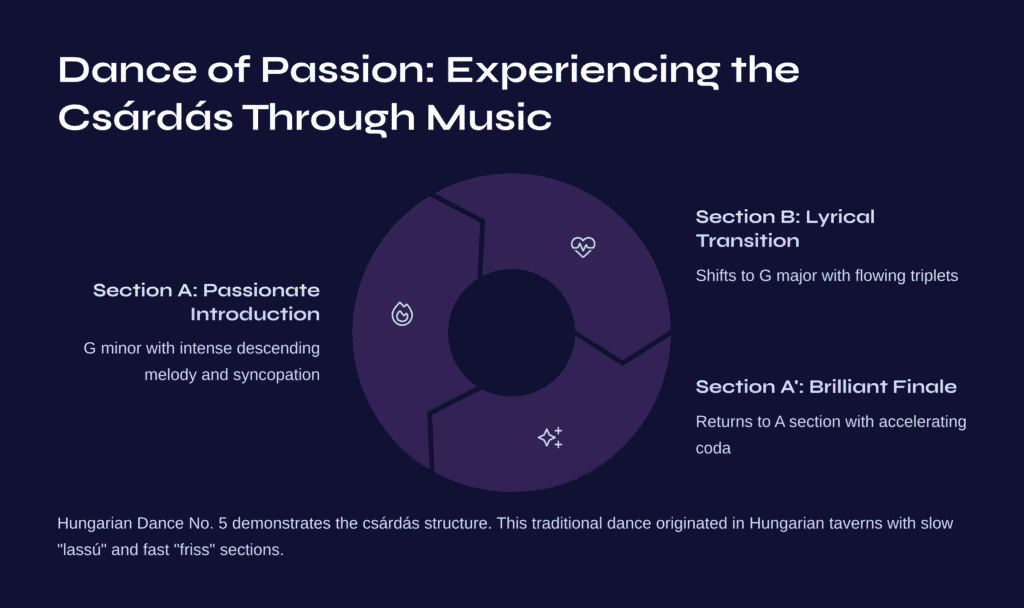
Dance of Passion: Experiencing the Csárdás Through Music
Hungarian Dance No. 5 beautifully demonstrates the characteristics of a typical “csárdás.” The csárdás originated in Hungarian taverns (“csárda”) as a couples’ dance consisting of two contrasting sections: the slow, melancholic “lassú” and the fast, passionate “friss.”
Brahms’ Hungarian Dance No. 5 is structured in ABA’ form, perfectly reflecting these csárdás characteristics.
Section A: Passionate Introduction
The A section in G minor begins with an intense descending melody and syncopation. This section, reminiscent of a galloping horse, was inspired by Gypsy violin playing and features a distinctive dotted rhythm (♩.♪). Despite its simple harmonic progression, it builds tension through chromatic developments and unexpected accents.
Section B: Lyrical Transition
The B section suddenly shifts to G major, presenting a lyrical melody that contrasts with the passion of the A section. Flowing triplets and hemiola rhythms intersect to create a unique tension. This section feels like the moment when a dancing couple catches their breath and gazes at each other.
Section A’: Brilliant Finale
A shortened A section returns, and the piece concludes with an accelerating coda. In the final part, the tempo increases further, creating a brilliant finale like a fireworks display.
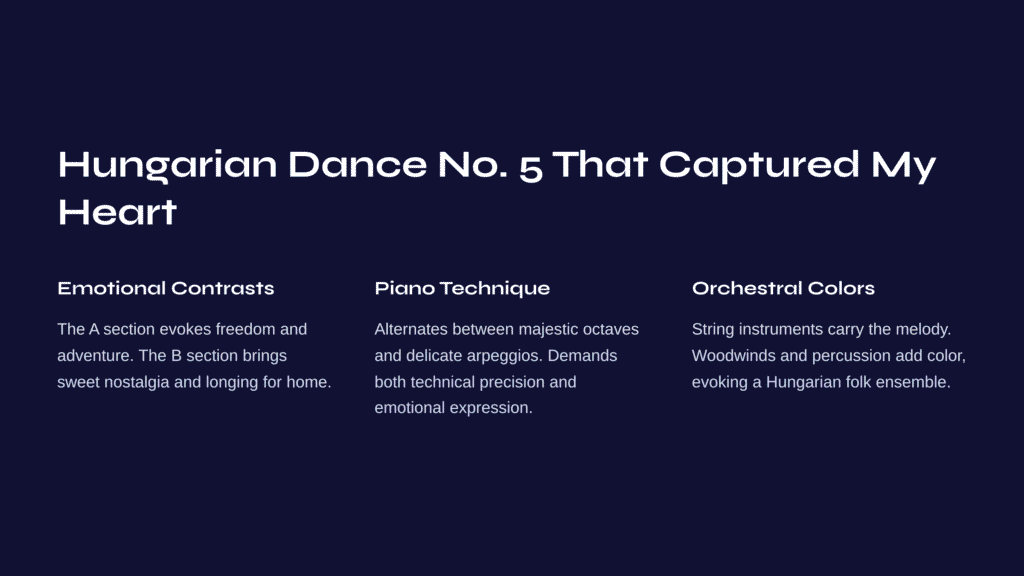
Hungarian Dance No. 5 That Captured My Heart
What particularly captivates me about this piece is its contrasting emotional expression. When listening to the intense A section, I feel a sense of freedom and adventure, as if riding a horse across the plains. Conversely, the lyrical melody of the B section evokes a longing for home or the sweet nostalgia of remembering a loved one.
When I played this piece while learning piano, I could feel how Brahms explored the possibilities of the instrument. The piano technique that alternates between majestic octaves and delicate arpeggios demands both technical precision and emotional expression. Playing this piece, which feels like riding an emotional roller coaster, is always challenging yet immensely enjoyable.
Additionally, when listening to the orchestral version, it’s fascinating to discover how each instrument mimics the sounds of a folk ensemble. The way string instruments carry the main melody while woodwinds and percussion add color and rhythm evokes the ensemble playing of a Hungarian folk group.
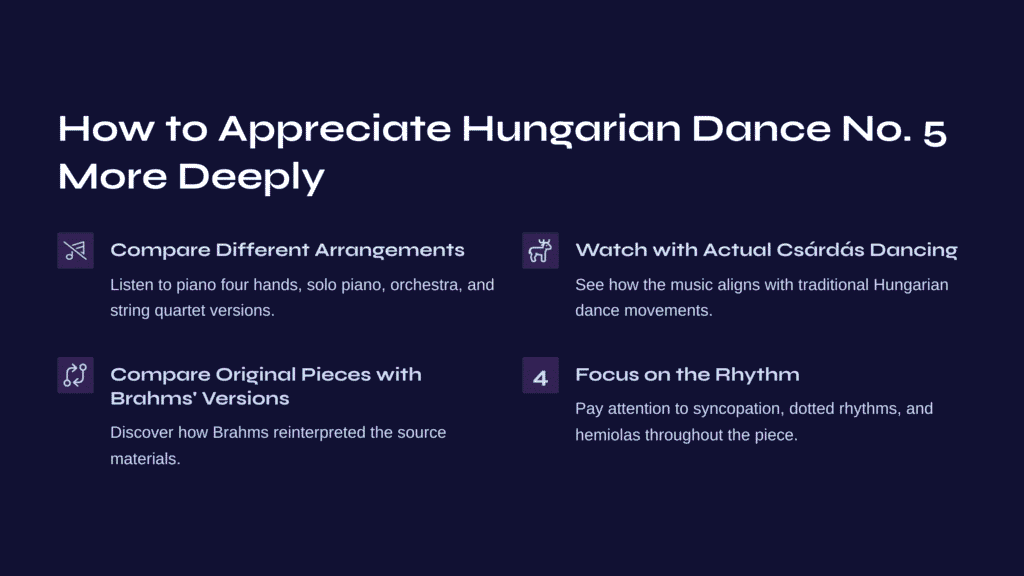
How to Appreciate Hungarian Dance No. 5 More Deeply
Here are some tips for those who want to appreciate this charming piece more deeply:
- Compare Different Arrangements: Originally composed for piano four hands, this piece has been arranged for solo piano, orchestra, string quartet, and more. Compare various interpretations, from orchestral versions by famous conductors like Claudio Abbado and Herbert von Karajan to solo performances by pianists like Martha Argerich.
- Watch with Actual Csárdás Dancing: Look up traditional Hungarian csárdás dancing on YouTube and imagine how this music aligns with the dance movements. Understanding the connection between music and dance will help you feel the rhythm and changes in the piece more deeply.
- Compare Original Pieces with Brahms’ Versions: Recently, there have been recordings that include both Brahms’ Hungarian Dances and their source materials. Comparing how Brahms reinterpreted the original pieces can be an interesting experience.
- Focus on the Rhythm: Pay attention to the various rhythmic patterns that appear throughout the piece, such as syncopation, dotted rhythms, and hemiolas. Feeling how these rhythmic changes breathe life and tension into the music is rewarding.
- Feel the Emotional Contrast: Consciously experience the emotional contrast between sections A and B. The journey of emotions—from passion to lyricism and back to passion—is the core of this piece’s appeal.
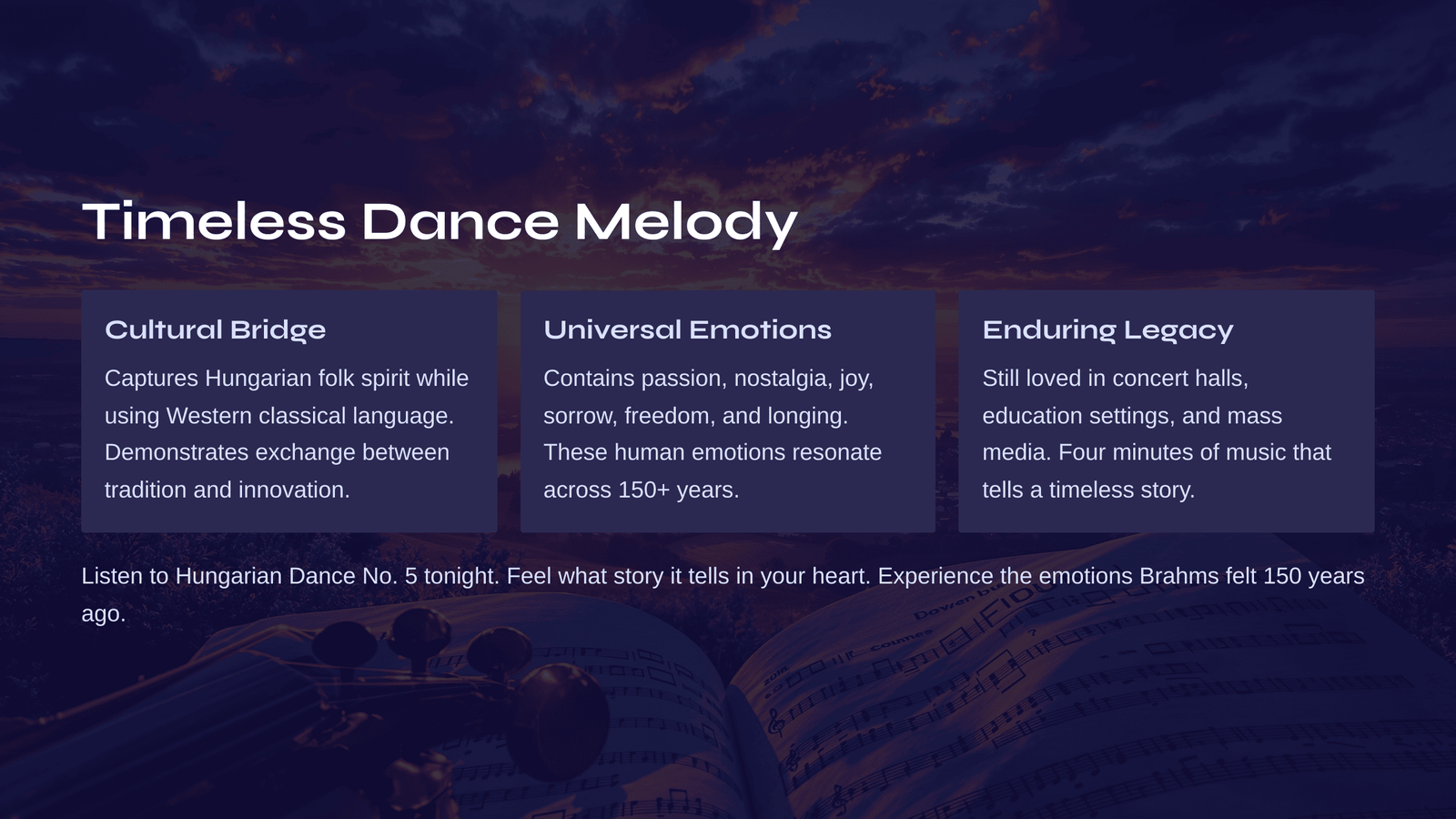
Timeless Dance Melody
Brahms’ Hungarian Dance No. 5 is more than just a classical masterpiece; it is a product of musical dialogue that transcends cultural boundaries. This work, which captures the spirit of Hungarian folk music while reinterpreting it in the sophisticated language of Western European classical music, demonstrates the vibrant exchange between folk tradition and artistic innovation.
More than 150 years after its composition, the reason this piece is still loved in concert halls, music education settings, and mass media is probably due to the universal emotions it contains. Passion and nostalgia, joy and sorrow, freedom and longing… all these human emotions are vividly contained within just over four minutes of music.
This evening, listen to the melody of Hungarian Dance No. 5. And feel what story the music tells in your heart. Perhaps you will experience the same emotions that Brahms felt 150 years ago.
If You Loved This, Listen to This Next
If the intense emotions and dance-like rhythms of Brahms’ Hungarian Dance No. 5 moved you, you might find a powerful contrast in Bach’s ‘Mass in B Minor’ – The First “Kyrie eleison.” This monumental choral work opens with a solemn plea for mercy, blending intricate vocal lines and orchestral grandeur to create a transcendent, spiritual atmosphere. Discover the profound beauty of Bach’s masterpiece here.
